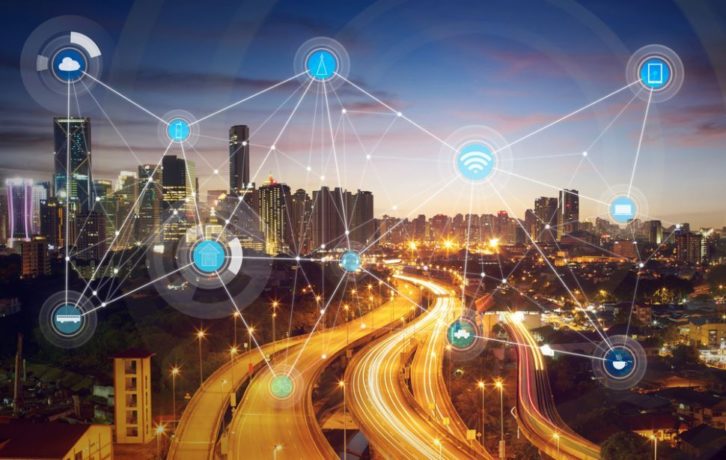
The idea of a ‘smart city’ has theoretically existed for thousands of years, tracing back to ancient Rome where new technologies were applied through a complex interconnected urban system, which constructed its public transport systems and distributed energy sources. Once the aqueducts, water drainage systems, and paved roads were put in place, the lives of citizens were transformed.
Over the last 1,500 years, technology has advanced so rapidly that we are now witnessing a digital age, with innovations such as driverless cars, intelligent traffic systems, and delivery bots. The evolution of technological advancement is seeing great progress, yet we need to understand that empires are not built in a day.
Smart cities via edge technology
To deal with the vast amount of data available in the modern age, it is crucial to have a high bandwidth and low-latency network in place to build the most effective smart cities. Whilst roll-outs of reliable and affordable 5G have been deployed across cities across the world, we are still seeing some lack of network connectivity in certain areas.
The answer? Edge computing: a distributed computing paradigm that brings computer and data storage closer to the sources of data. Edge technology allows faster decisions to be made, and data processed in real-time within the device itself, as opposed to needing to send information to a faraway data center for processing. Response times are therefore quicker – a key factor when it comes to managing the high bandwidth technologies that are essential for smart cities and ensuring that they are a success.
An edge computing network also tends to be more reliable and cost-efficient – a win-win for local governments. This is because, with on-device decision-making via artificial intelligence, data does not have to be stored on a cloud network as only important data is processed.
Barcelona: A leading example
Barcelona is one city leading the way in implementing smart, data-driven technology with the aim of improving the lives of its citizens. In 2015, the city started a process of network transformation through a series of pilot schemes and work is continuing today. On top of developing a 5G network and private infrastructure, Barcelona is working with partners such as Lenovo to explore other use cases for building a future with smarter technology. Self-driving 5G buses, for example.
If this sounds like a pipe dream, think again, because the project is already under way. In collaboration with Fira de Barcelona – the city’s fair-trade institution – it aims to provide sustainable mobility solutions in large, enclosed spaces.
The project is supported with the infrastructure for the overall deployment of a private 5G stand-alone network. Beyond transport, it will also be deployed to help law enforcement in the city. By using a video feed that can be analyzed in real-time using AI, police will be able to detect crimes and protect the public. Put simply, technology is ultimately able to provide substantially more resources to the emergency services, meaning they can react faster when the need arises.
Having already built more than 3,000 street cabinets to hold key tech infrastructure, Barcelona has an incredible opportunity to continue its path to digital transformation. As such, the city has set out ambitious plans which will set the tone when it comes to efficiency, transparency, and social innovation. And while we can look to Barcelona as an example, it is important to remember that one size does not fit all. As a coastal city and popular tourist destination, its challenges are different to those in the rest of the world.
Different city, different challenges
All cities will have different needs and challenges as they strive to become smarter. To maximize the benefits, these must be accounted for from the beginning. Barcelona, for example, is a popular beach-side holiday destination. Therefore, network capacity management in crowded environments such as the beach is extremely important. In its latest pilot, Barcelona aims to adapt its 5G strategy in order to ensure its network capabilities are flexible while also extending connectivity services to shaded areas where network resource needs are highly seasonal, such as beaches.
Mexico, however, has a very different challenge, posed by widespread water shortages. These shortages have worsened amid extreme temperatures due to climate change, so that is where the authorities have focused their efforts. Indeed, Mexico is already leading the way when it comes to smart cities in LATAM, with four cities – each with unique challenges – considered Intelligent Cities by the Inter-American Development Bank (IDB).
By taking a smart approach to infrastructure, the country will be able to use technology to effectively monitor water levels and consumption. And in the process ensure the infrastructure is in place to overcome water shortages – the modern-day equivalent to what the Romans achieved.
Despite each city having different needs, there is a specific set of characteristics that help to identify and measure its level of ‘smartness’. Smart cities are based on the idea that people can live and work in the most efficient way while making the most of their resources. For example, by collecting data on energy usage both from a personal level and within building control systems, consumption can be reduced. Combining that with managing traffic and keeping a close eye on air quality can help cities – and entire countries – hit emissions targets.
In addition, by looking at live data, measures can be taken to reduce harmful levels of air pollution, such as issuing restrictions on traffic in certain areas. Congestion can then be combated by monitoring live video streams and signaling controls to ensure cities keep moving.
The smarter future
Challenges will always exist in the path of creating a smart future for our cities. As servers are increasingly being placed on highways or streets, it is more important than ever to monitor physical security. With the fundamental functions of the smart city established, to ensure the processes are running smoothly, protection should also be put into place to ensure a clear strategy for success.
In comparison to Barcelona, which has over 3,000 street cabinets constructed, bigger cities will naturally have a higher quantity demand for their infrastructure to ensure coverage – this is where edge computing comes in. Sensors can survive a network outage or inconsistent coverage individually without needing a central cloud control system.
Cities are expected by the local governments to be as productive and efficient as they can be, whilst minimizing costs at the same time. Smart initiatives will help to push this forward. Smart cities require a long-term effort to gain a clear vision and understanding of the unique infrastructure and community needs of every city. Edge computing plays a vital role in underpinning urban spaces and understanding the distinctiveness of each city, and smart cities will make lives easier now and in the future.
This article originally appeared on techradarpro.com
About the Author
Antonio Bocigas is the Telco Director for Lenovo EMEA.












